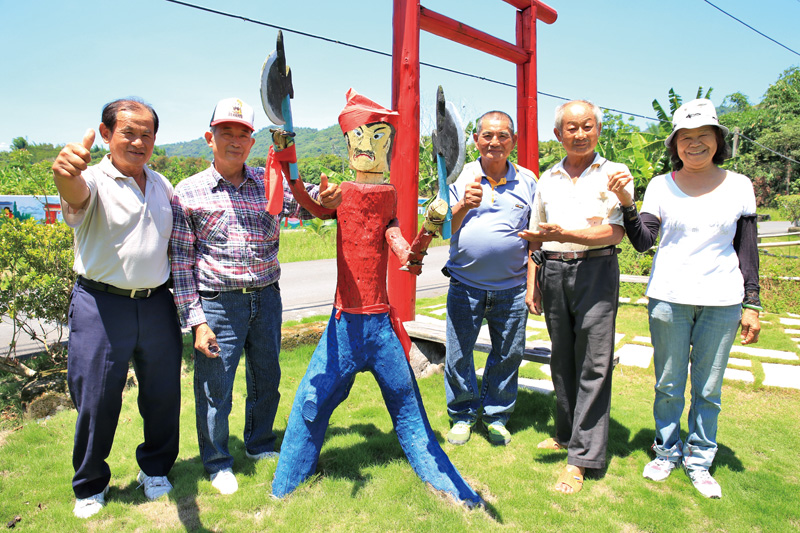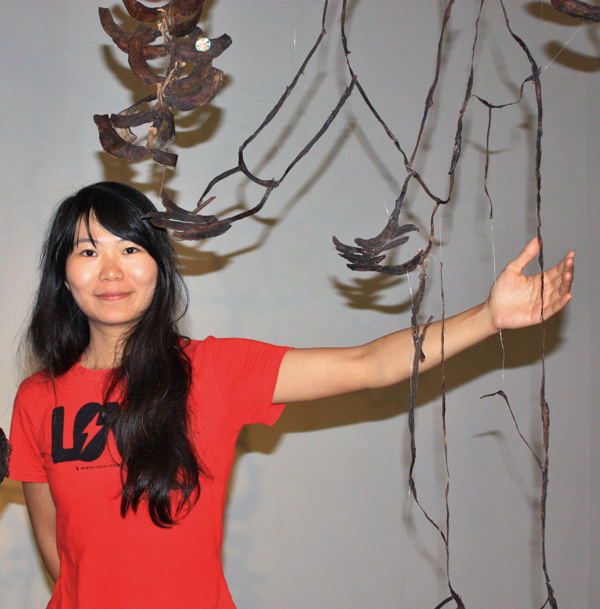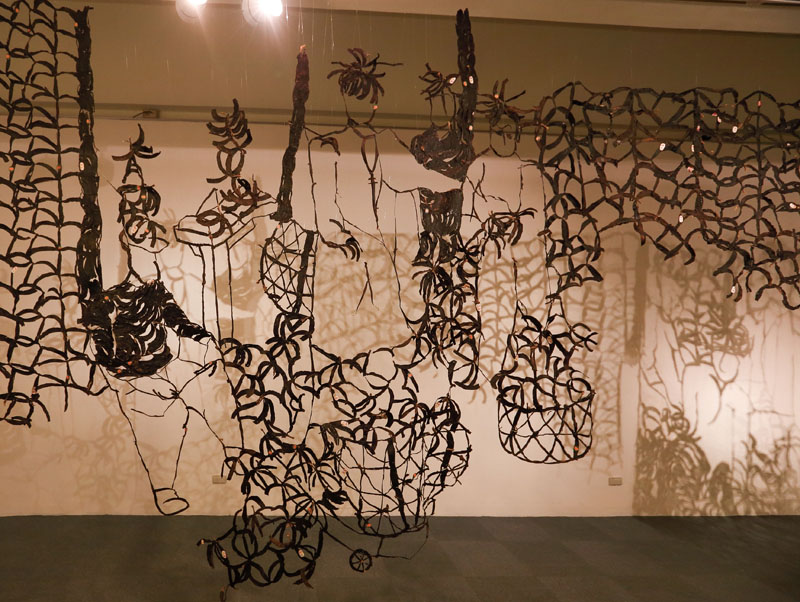Songjiang Wooden Puppet Installation in Neimen Park/內門區溝坪里吸睛的宋江木偶工藝品
Songjiang Wooden Puppet Installation in Neimen Park
◎English translation: Lin Fang ju
◎Photo by Lin Yu-hung
Neiman District is famous for its unique martial-arts troupes which are considered an important part of the region's cultural heritage. There are more than 50 Songjiang martial-arts troupes in the district. Locals enthusiastically join local troupes, contributing to an extraordinary regional culture. In order to embody this phenomena, a display of hand carved Songjiang puppets have been installed in Neimen's Smile Green Park, located in Gouping Village on the district's east side.
 The display was a collaborative creation by the people of Neimen and only utilizes resources that come from the district. The puppets were hand carved by resident artisans out of regional longan wood. The entire installation including the pavilions and benches were also created by locals. Longan branches were used as the body of puppets. The puppets faces are painted with vivid and unique expressions. Household items such as rice cookers and gas barrels were also contributed by locals to add to the installation. "These animated Songjiang puppets demonstrate how important this unique cultural element is for our community", says Liu Ruei-ji, Gouping Community Development Council Chairman.
The display was a collaborative creation by the people of Neimen and only utilizes resources that come from the district. The puppets were hand carved by resident artisans out of regional longan wood. The entire installation including the pavilions and benches were also created by locals. Longan branches were used as the body of puppets. The puppets faces are painted with vivid and unique expressions. Household items such as rice cookers and gas barrels were also contributed by locals to add to the installation. "These animated Songjiang puppets demonstrate how important this unique cultural element is for our community", says Liu Ruei-ji, Gouping Community Development Council Chairman.
Smile Green Park was selected as the location for the installment which has become a popular attraction. Locals frequently use the park to take walks, chat with neighbours and maintain the upkeep of the park. Smile Green Park won a 2015 Yuan-Yie Award in the Community Landscaping Category. This exciting success has inspired the people of Gouping to collaboratively create a second park.
內門區溝坪里吸睛的宋江木偶工藝品
◎文/侯雅婷
◎攝影/林裕鈜
高雄市內門區「宋江陣」名聞遐邇 ,但宋江文化深刻影響內門的每個角落,也是內門人最引以為傲的文化資產。
內門區約有50多個陣頭,居民樂於參與當地陣頭成就內門獨特的陣頭文化。每年觀音佛祖聖誕時,各庄頭於觀音佛祖面前獻藝表達祝壽之意,內門居民日積月累的紮實功夫展現出凌空騰躍的姣好身手,總贏得一陣滿堂彩;而內門區東邊溝坪里居民就地取材,以龍眼木打造出神韻到位的Q版的宋江木偶工藝品,為發揚宋江文化另闢蹊徑。「這些Q版宋江木偶工藝品代表溝坪里居民的文化認同。」溝坪社區發展協會理事長劉瑞吉如是說。
這3尊矗立在「微笑綠園」公園的宋江木偶工藝品是當地的一大亮點,值得一提的是,從涼亭、椅子到裝置藝術都由居民取用當地石材、木材合力打造而成,裝置藝術更是居民的創意大集合,居民挑選與人身形相仿的龍眼木枝幹做為木偶肢幹,塗繪木偶五官,活靈活現的宋江木偶工藝品更顯得獨一無二。而以電鍋和瓦斯桶等日常用品打造出頗具巧思的裝置藝術,讓人會心一笑。這裡成為居民散步的好去處,居民總邊閒聊 、邊拔除公園雜草,公園裡綠草如茵,「微笑綠園」更榮獲今年度園冶獎「社區景觀類獎」獎項肯定,居民個個喜不自勝。
「微笑綠園」公園開啟溝坪居民闢建公園風氣,居民們透露將共同闢建第2 座公園,綠意已在溝坪里漫延開來。
Installation Artist Lo Yi-chun on Her Work: Banana in Taiwan, Japan and Philippines
◎English translation: Peng Hsin-yi
◎Photos by Huang Ching-wen, Lin Yu-hung
 The annual Kaohsiung Awards are a significant event in Taiwan's art scene, and this year's winners were displayed in Kaohsiung Museum of Fine Arts from March 17 to June 6.
The annual Kaohsiung Awards are a significant event in Taiwan's art scene, and this year's winners were displayed in Kaohsiung Museum of Fine Arts from March 17 to June 6.
The installation work that took First Place generated a very enthusiastic public response. "Banana in Taiwan, Japan and Philippines" by Ms. Lo Yi-Chun took the top prize among this year's 625 participants.
Ms. Lo's work was mainly made with dried banana peels. Since bananas have long been associated with Kaohsiung's Cishan District, a work of art utilizing this fruit strikes Kaohsiung people as both fun and homely.
A subtle scent of sweet bananas wafted through the exhibition room where "Banana" was displayed. The entire work was a dark brown hue, the natural color of dehydrated banana peels. The crescent peels were arranged to create a three-dimensional collage suspended in the middle of the room, with lighting to project the installation's silhouette on the four walls. Like a shadow play, these told stories held in the artist's mind. Visitors walking through the room were able to see different shapes and images from different angles.
Back in 2013, Ms. Lo was an artist-in-residence artist at the Bank ART Studio NYK in Yokohama, Japan. This program encourages artists to embrace local themes in their creations. Ms. Lo says that during this period, she felt lonely and homesick. These feelings inspired her to use a material which reminded her of her home in Taiwan. This is how the banana peel became a vessel for her creativity.
Knowing that Taiwanese bananas used to be a significant export to Japan, she conceived of a theme for her work. She visited pastry stores to collect banana peels, which she then placed on sheets of newspaper to draw out the moisture. The drying process took four to five days. She fashioned her work after a 1950s photo showing Taiwan's banana market during its golden period.
After sewing together, the dried banana peels are like pen strokes. They form images, and Ms. Lo opted to present them in a three-dimensional manner by hanging the images in a room rather than paste them on a surface. Ms. Lo says she decided to retain the stickers on the peels, because she wants audiences to grasp how this unassuming fruit has become a valuable international commodity.
Ms. Lo's dried banana peels have traveled from Japan to the United States, and now to Taiwan. Her exhibition has given audiences in all three countries a sense of pleasant surprise as they gazed upon it.
藝術家羅懿君談 芭娜娜‧バナナ‧Saging
◎文/侯雅婷
◎攝影/黃敬文、林裕鈜
 藝術家羅懿君以風乾的香蕉皮製成「芭娜娜‧バナナ‧Saging」作品,從625位參賽者中脫穎而出,榮獲「2015高雄獎」的「高雄獎」獎項。今年3月17日至6月6日於高美館展出期間 ,引起廣大迴響。高雄旗山區盛產香蕉 ,有著「香蕉王國」美名,以香蕉皮為創作媒材,讓人覺得格外親切、有趣。
藝術家羅懿君以風乾的香蕉皮製成「芭娜娜‧バナナ‧Saging」作品,從625位參賽者中脫穎而出,榮獲「2015高雄獎」的「高雄獎」獎項。今年3月17日至6月6日於高美館展出期間 ,引起廣大迴響。高雄旗山區盛產香蕉 ,有著「香蕉王國」美名,以香蕉皮為創作媒材,讓人覺得格外親切、有趣。
「芭娜娜」作品展場飄著淡淡果香,風乾的黑褐色香蕉皮組構而成的圖畫,呈現剪影般的效果,裝置出一幅幅故事,透過投射燈打光在前方的黑色的香蕉皮圖畫,映在白色牆面的影子豐富了展場的視覺效果,風乾的香蕉皮組合變化出線條與肌理,參觀者從不同的角度繞著懸掛、簍空的作品,每個角度都是一番景致,趣味盎然。
2013年羅懿君參與日本橫濱市藝術駐村計劃(Bank ART Studio NYK),以當地題材發想,發表創作作品。羅懿君說,人在異鄉的她感覺孤單、想家了,遂以台灣常見的香蕉皮為創作媒材,台灣香蕉外銷日本的故事給了她創作靈感。她在當地的甜點店收集創作所需的香蕉皮,以報紙吸收香蕉皮水份,歷經4~5 天製成香蕉皮乾,她以一張1950年代台灣香蕉市場交易盛況的老照片為藍圖,運用風乾後的香蕉皮以線狀概念連接、組成圖像,並以懸掛的裝置方式呈現,羅懿君說,她特意保留香蕉上產地標籤貼紙,讓觀眾得以從標籤貼紙一窺跨國香蕉市場風起雲湧的故事。
羅懿君將風乾的香蕉皮作品跨越國度,在日本、美國和台灣展出都讓人眼睛為之一亮,大放異彩。